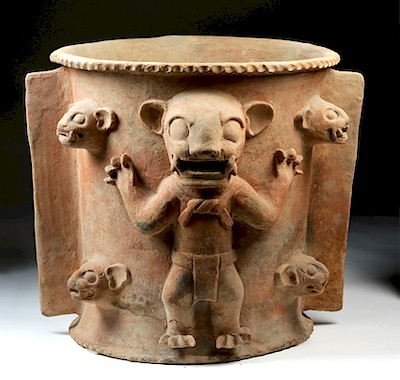Fine Luristan Bronze Short Sword
Lot 59a
About Seller
Artemis Fine Arts
686 S Taylor Ave, Ste 106
Louisville, CO 80027
United States
Selling antiquities, ancient and ethnographic art online since 1993, Artemis Gallery specializes in Classical Antiquities (Egyptian, Greek, Roman, Near Eastern), Asian, Pre-Columbian, African / Tribal / Oceanographic art. Our extensive inventory includes pottery, stone, metal, wood, glass and textil...Read more
Estimate:
$2,500 - $3,500
Absentee vs Live bid
Two ways to bid:
- Leave a max absentee bid and the platform will bid on your behalf up to your maximum bid during the live auction.
- Bid live during the auction and your bids will be submitted real-time to the auctioneer.
Bid Increments
| Price | Bid Increment |
|---|---|
| $0 | $25 |
| $300 | $50 |
| $1,000 | $100 |
| $2,000 | $250 |
| $5,000 | $500 |
| $10,000 | $1,000 |
| $20,000 | $2,500 |
| $50,000 | $5,000 |
| $100,000 | $10,000 |
| $200,000 | $20,000 |
About Auction
By Artemis Fine Arts
Dec 6, 2018
Set Reminder
2018-12-06 10:00:00
2018-12-06 10:00:00
America/New_York
Bidsquare
Bidsquare : DAY 2 : Pre-Columbian, Ethnographic & Fine Art
https://www.bidsquare.com/auctions/artemis-gallery/day-2-pre-columbian-ethnographic-fine-art-3699
Day 2 of an important 2-dy auction featuring ancient and ethnographic art from around the world. Today's sale will feature Pre-Columbian, Native American, African / Tribal, Ethnographic, Spanish Colonial, Fine Art, much more. Artemis Fine Arts info@artemisgallery.com
Day 2 of an important 2-dy auction featuring ancient and ethnographic art from around the world. Today's sale will feature Pre-Columbian, Native American, African / Tribal, Ethnographic, Spanish Colonial, Fine Art, much more. Artemis Fine Arts info@artemisgallery.com
- Lot Description
Ancient Near East, northwestern Iran, Luristan, ca. 1000 to 600 BCE. A wonderful bronze short sword with a diamond-shaped handle, made by highly-trained urban artisans using the lost wax (cire perdue) technique. The blade was cast first, and then the handle was cast onto its end. The handle would have been originally wrapped with leather or something similar to create a gripping surface. The handle has a rectangular hand guard with several parallel striations, and the pommel has an elaborate double-eared presentation. The blade is narrow and triangular with thick shoulders and a raised central midrib on both sides. A beautiful example covered with lustrous green and brown patina. Size: 2.125" W x 21.8" H (5.4 cm x 55.4 cm).
The region of Luristan, which encompasses the rugged Zagros Mountain chain, is famous for its metal craftsmanship that was above and beyond the skill level of contemporary groups. The affluent group in Luristan society that patronized the metalworking industry and purchased fine items like this dagger were nomadic horsemen. They would travel into towns and purchase swords and other bronze and iron objects from craftsmen there. Although these horsemen were pre-literate, we know from the records of the Elamites and other southern neighbors that these tribesmen functioned as mercenaries in the constant warfare between the Sumerians, Babylonians, Assyrians, and Elamites. When they died, they were buried in rock-covered tombs with weapons like this one.
Provenance: private East Coast, USA collection; ex-Artemis Gallery; ex-private Green collection, York, England, United Kingdom; ex-David Kennedy collection, acquired in the London Art Market in the late 1980s
All items legal to buy/sell under U.S. Statute covering cultural patrimony Code 2600, CHAPTER 14, and are guaranteed to be as described or your money back.
A Certificate of Authenticity will accompany all winning bids.
We ship worldwide and handle all shipping in-house for your convenience.
#142280Blade is slightly loose and has small but stable fissures along area between blade and handle. Minor nicks to blade edges, handle, and pommel, and softening to some finer details. Light earthen deposits and great green and brown patina throughout.Condition
- Shipping Info
-
All shipping is handled in-house for your convenience. Your invoice from Artemis Gallery will include shipping calculation instructions. If in doubt, please inquire BEFORE bidding for estimated shipping costs for individual items.
-
- Buyer's Premium



 EUR
EUR CAD
CAD AUD
AUD GBP
GBP MXN
MXN HKD
HKD CNY
CNY MYR
MYR SEK
SEK SGD
SGD CHF
CHF THB
THB














